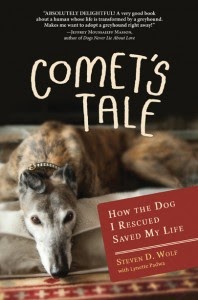| Sao Tome Shrew |
I don't normally use this blog to promote books (with the exception of my own,) but I recently participated in the Northern California Independent Booksellers conference in South San Francisco. One of the books I picked up was Comet's Tale: How the Dog I Rescued Saved My Life, not because I rescue greyhounds, but because a dear friend does and it was her birthday. What caught my eye was the subtitle. If you've read this blog more than once, you know I believe in the healing power of our relationship with animals, and the natural world in general. Animals we adopt as pets to give them better lives frequently lead us to understand it is they who enrich ours. Animals as healers is a theme that runs throughout everything I've ever written, so I carefully read Comet's Tale before giving it to Tanya.
I'm extrapolating here, but too often the question that arises before any consideration is giving to saving a unique habitat and the species found in it--a polar bear or Preble’s meadow jumping mouse--is what purpose does it serve? How is mankind any richer for saving a Sao Tome shrew or a Pig-nosed frog?
That should never be the question. The question should be what right do we have to destroy it? However, for those who think the former question trumps the latter, perhaps greyhounds need protection because we have thousands of veterans coming back from our wars who need help, and
Even if a racer survives (the risks involved in racing,) the dog’s long-term prospects are grim. Hounds who never place in the money far outnumber the winners, and even the winners will start losing one day. Most of the losers are three years old or younger. Because food and care cost money, no racing kennel wants to keep them around. Since greyhound breeders produce tens of thousands of dogs ever year, it’s easy to obtain a replacement. The president of the Pensacola Greyhound Assoc. summed it up the industry attitude when he said, “That’s just a bad part of the business, unfortunately. I compare it to owning a professional sports team. If you have one of you star players who isn’t putting out, then you have to make other arrangements.”
The “arrangements” are what lie at the end of the road for hundreds of greyhounds. Some are killed legally by veterinarians hired by the dogs’ owners…then there is the other option, known within the industry as “going back to the farm.” A man named Robert Rhodes operated one such farm—eighteen acres in rural Alabama where he admitted to shooting thousands of greyhounds during his forty-year career in the racing industry. An aerial photo revealed an estimated three thousand greyhound skeletons scattered around his property. Rhodes, a security guard at a Florida
Something similar happened in Arizona Arizona
In addition to the massacre of greyhounds, there are a multitude of documented cases where greyhounds have simply disappeared. Thousands have been ‘donated’ to medical research, and many more have been transported to other countries. Advocates for the Greyhound Protection League say that 24,000 is a conservative estimate of the yearly number of greyhound killings that occurred during the racing industry’s heyday from the mid-1980s to the early 2000s.
‘If there is anyone to indict here, it’s the industry because this is what they’re doing to these animals. They misery begins the day they’re born. The misery ends when my client gets ahold (sic) of them and puts a bullet in their head(s).' That is how Robert Rhode’s attorney attempted to defend his client’s actions as late as 2003. The defense was ridiculous, but his observations about the industry were on target. A racing greyhound’s misery does begin the day the dog is born. However, owing to growing public awareness, greyhounds are being rescued and adopted in ever increasing numbers. By 2003, 18,000 retired racers were being placed with families each year. Unfortunately, that still left 7000 hounds who were needlessly put to death. While the numbers might be fewer today, the percentages haven’t necessarily improved.
Comet's Tale: How the Dog I Rescued Saved My Life is available from the following booksellers http://www.indiebound.org/book/9781616200459



No comments:
Post a Comment
Note: Only a member of this blog may post a comment.